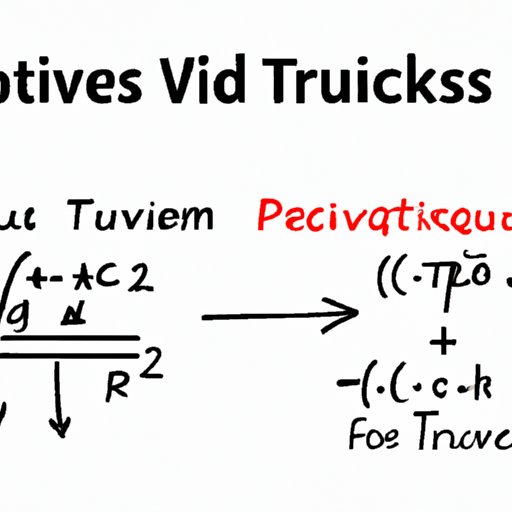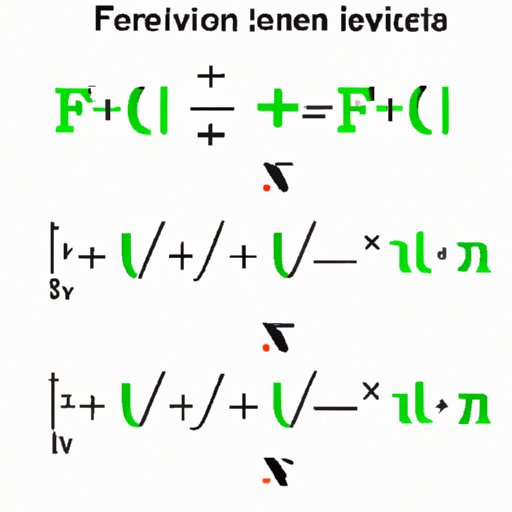Introduction
Have you ever wondered how to find the inverse of a function? In mathematics, inverse functions are essential tools used in many fields, from calculus to statistics. They allow us to reverse the order of operations and solve complex problems. In this article, we will explore the fundamentals of inverse functions and provide techniques for finding them.
Understanding the Concept of Inverse Functions: A Comprehensive Guide
Inverse functions are like a mirror image of the original function. They exist when each unique input in a function corresponds to only one output, and vice versa. In simpler terms, it means that when the original function takes an input and gives a particular output, the inverse function takes that output and gives back the same input as the original function.
The inverse function of a function f(x) is represented as f⁻¹(x), where the superscript -1 signifies the inverse function.
A fundamental property of inverse functions is that when they are composed, they yield the identity function, which is the function that returns any value input into it.
There are two major properties of inverse functions. The first property is that the domain and range of the original function switch in the inverse function. In other words, the output values of the original function become the input values of the inverse function, while the input values of the original function become the output values of the inverse function.
The second property is that the composition of a function with its inverse function gives the identity function.
There are three types of inverse functions: one-to-one functions, inverse functions with domain restrictions, and inverse functions with range restrictions.
A Beginner’s Guide to Finding the Inverse of a Function
Let’s begin by understanding the basic steps for finding the inverse of a function:
- Write down the original function as y = f(x).
- Swap the positions of x and y, i.e., interchange the letters x and y.
- Solve for y in the resulting equation to obtain y = f⁻¹(x).
For example, let’s say we have a function f(x) = 3x + 2.
Step 1: Write down the original function as y = f(x).
y = 3x + 2
Step 2: Interchange the variables x and y.
x = 3y + 2
Step 3: Solve for y.
x – 2 = 3y
y = (x – 2)/3
So the inverse function is f⁻¹(x) = (x – 2)/3.
5 Simple Steps to Find the Inverse of Any Function
Here are five easy-to-understand steps for finding the inverse of any function:
- Write the original function as y = f(x).
- Replace y with f⁻¹(x) and x with y.
- Solve for f⁻¹(x) using algebraic manipulation.
- Determine the domain and range of the inverse function f⁻¹(x).
- Check your answer by verifying that f(f⁻¹(x)) = x.
Let’s apply these steps to the function f(x) = 2x – 1:
Step 1: Write down the original function as y = f(x).
y = 2x – 1
Step 2: Replace y with f⁻¹(x) and x with y.
x = 2f⁻¹(x) – 1
Step 3: Solve for f⁻¹(x) using algebraic manipulation.
f⁻¹(x) = (x + 1)/2
Step 4: Determine the domain and range of the inverse function f⁻¹(x).
The domain of f(x) is all real numbers, but the range of f(x) is restricted to all real numbers greater than or equal to -1. Therefore, the domain of f⁻¹(x) is all real numbers greater than or equal to -1, and the range of f⁻¹(x) is all real numbers.
Step 5: Check your answer by verifying that f(f⁻¹(x)) = x.
f(f⁻¹(x)) = f((x+1)/2) = 2((x+1)/2) – 1 = x + 1 – 1 = x
Therefore, the inverse function is correct, and we have solved for f⁻¹(x) = (x + 1)/2.
Exploring the Different Techniques to Find the Inverse of a Function
There are different methods for finding the inverse of a function, such as graphical, algebraic, and numerical techniques.
The graphical method involves plotting the function and drawing a line y = x. The point(s) where the graph of the original function intersects the line y = x are the corresponding points on the inverse function.
The algebraic method involves using inverse operations to solve for the inverse function. This method is the most common and can be applied to most functions using the steps above.
The numerical method involves using numerical algorithms to approximate the inverse function. This method is used when the inverse function is too complex to solve algebraically and is often used in scientific and engineering applications.
Mastering the Art of Solving Inverse Functions with Ease
Sometimes, you will encounter more complex functions that require additional steps to solve for the inverse function. Here are some strategies for solving more difficult inverse functions:
- Break up the function into smaller parts and solve each part separately.
- Use trigonometric identities to simplify functions involving trigonometric functions.
- Use logarithmic and exponential properties to simplify functions involving logarithmic and exponential functions.
- Try to use symmetry to your advantage.
- Use online resources and software to check your answers and gain a better understanding of the problem.
Some common challenges when solving inverse functions include complex algebraic manipulations, functions with multiple solutions, and functions with domain and range restrictions. These challenges can be overcome by using the methods discussed above and by practicing regularly.

Quick Tips and Tricks to Find the Inverse of Any Function
Here are some quick tips and tricks to make the process of finding the inverse function easier and faster:
- Understand the properties of inverse functions and how they relate to the original function.
- Use the algebraic method for most functions.
- Use online resources and software to verify your answers and provide additional examples.
- Practice regularly and identify areas where you need to improve.
- Memorize common functions and their inverses, such as trigonometric functions and logarithms.
Common Mistakes to Avoid When Finding the Inverse of a Function
Some common mistakes people make when finding inverse functions include:
- Forgetting to switch the position of the variables x and y.
- Not simplifying algebraic expressions enough.
- Using the incorrect domain or range for the inverse function.
- Not checking their answer by verifying that f(f⁻¹(x)) = x.
These mistakes can be easily avoided by double-checking your solution and practicing regularly.
Conclusion
Inverse functions are essential tools in mathematics and have applications in many fields. Understanding the properties of inverse functions and how to find them is an important skill for success in any area of math. By using the techniques and strategies discussed in this article, you can master the art of finding inverse functions and become more confident in your mathematical abilities.
Remember to practice regularly, memorize common functions and their inverses, and be mindful of common mistakes. By doing so, you’ll be well on your way to mastering inverse functions and achieving success in your mathematical endeavors.
